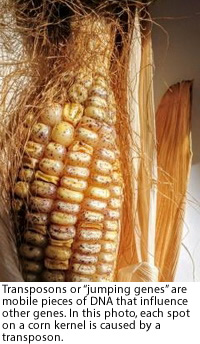
International Research Team Maps Jumping Genes of Maize
August 30, 2017| |
 An international team led by researchers from the University of California, Davis (UC Davis), and the Cold Spring Harbor Laboratory (CSHL) has mapped the transposable elements, or transposons of maize. Transposons, called jumping genes because they move locations within a genome, was discovered in maize by Nobel-winning geneticist Barbara McClintock in the 1940s.
An international team led by researchers from the University of California, Davis (UC Davis), and the Cold Spring Harbor Laboratory (CSHL) has mapped the transposable elements, or transposons of maize. Transposons, called jumping genes because they move locations within a genome, was discovered in maize by Nobel-winning geneticist Barbara McClintock in the 1940s.
Until now, the exact location of transposons has been elusive, as they are difficult to sequence and assemble. Michelle Stitzer, graduate student at UC Davis, and maize geneticist Jeff Ross-Ibarra, worked with colleagues at CSHL and several universities and genome technology companies to create a new maize reference genome that includes the many complex repeat regions.
According to Stitzer, transposons can regulate and change the expression of nearby genes depending on where they land in the genome. This is important to know, but difficult to identify earlier when their location in the genome sequence was still unknown. Stitzer added that transposon insertions, and their impact on gene expression, are known to impact the way in which the maize plant interacts with its environment. These insertions, for example, confer drought tolerance, altered flowering time, ability to grow in toxic aluminum-rich soils, and have allowed maize to spread to temperate latitudes by breaking sensitivity to the long days of the tropics.
For more, read the UC Davis News.
| |
Biotech Updates is a weekly newsletter of ISAAA, a not-for-profit organization. It is distributed for free to over 22,000 subscribers worldwide to inform them about the key developments in biosciences, especially in biotechnology. Your support will help us in our mission to feed the world with knowledge. You can help by donating as little as $10.
-
See more articles:
-
News from Around the World
- International Research Team Maps Jumping Genes of Maize
- Nigeria Should Turn to Biotech Amidst Population Boom
- Delays in Biotech Crop Approvals in Africa Amplifies Malnutrition
- Genetic Map Reveals Heat Tolerance Traits in Peas
- Plant 'Smells' Insect Foe, Defends Self
- MSU Food Literacy Poll Shows Consumers Are Confused about GM Foods
- Study Says Americans OK with GM for Health Care, Still Wary About Food
- ABCA Releases Updated Agricultural Biotechnology Guide
- Biotech Crop Regulation Based on Sound Science Needed for Myanmar, says Permanent Secretary
- Study Finds Hormonal Interactions Regulate Growth of Plant Roots
- GE Plants with Algae Genes Could Improve Crop Yields
-
Research Highlights
- GaMYB85 Plays a Role in Drought Tolerance in Transgenic Arabidopsis
-
Beyond Crop Biotech
- Biotech Moths to be Field Tested in NY
- Plant-produced Zika Virus Vaccine Confers Protective Immunity in Mice
-
Plant
- CRISPR-mediated Knockout of SaF/SaM Overcomes the Hybrid Male Sterility in Rice
-
Read the latest: - Biotech Updates (December 10, 2025)
- Gene Editing Supplement (November 26, 2025)
- Gene Drive Supplement (February 22, 2023)
-
Subscribe to BU: - Share
- Tweet
